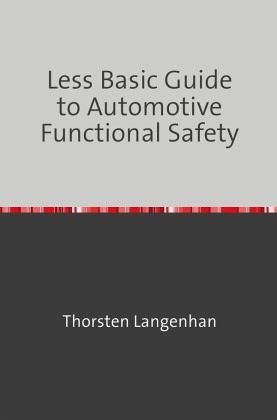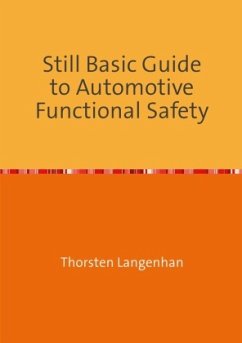
Thorsten Langenhan
Broschiertes Buch
Less Basic Guide to Automotive Functional Safety
Versandkostenfrei!
Versandfertig in 6-10 Tagen

PAYBACK Punkte
0 °P sammeln!




The book explains the requirements of ISO 26262:2018 and IEC 61508 Functional Safety norms for process compliance, quality assurance and system, hardware and software development requirements. The requirements attributes for safety requirements are described. Safety analyses like HARA, FMEA, FMEDA /HwFM, DFA, CCA, FoiA, pin-level FMEA are explained, as well as the metrics SPFM, LFM PMHF and FRC. Software development approaches with static code checks in acc. with MISRA coding rules, style guides and code reviews and tests. The book is meant as a guide with explanations and examples.
Langenhan, ThorstenThorsten Langenhan has 20 years of working experience as engineer in different branches and for different companies. In 2010 he entered the world of functional safety. He has been then safety manager at smaller and greater companies in the international automotive world as well as consultant for functional safety across all kind of branches.
Produktdetails
- Verlag: epubli
- 6. Aufl.
- Seitenzahl: 468
- Englisch
- Abmessung: 205mm x 135mm x 26mm
- Gewicht: 535g
- ISBN-13: 9783754950364
- Artikelnr.: 63437468
Herstellerkennzeichnung
Die Herstellerinformationen sind derzeit nicht verfügbar.
By taking a glance at the table of contents, this books seems to give a complete overview on the topic of Automotive Functional Safety. But it does not unfortunately.
After having taken time to read it I found it lacking in multiple aspects. On content:
-Chapters are not very structured and …
Mehr
By taking a glance at the table of contents, this books seems to give a complete overview on the topic of Automotive Functional Safety. But it does not unfortunately.
After having taken time to read it I found it lacking in multiple aspects. On content:
-Chapters are not very structured and clearly written (at least not to me), instead lots of them seem to rather be a collection of views of the author randomly grouped together. Makes what is already a tough topic not easier to understand.
-Necessary detail is lacking on key topics. For example: what is an DFMEA exactly? A precise definition is expected, examples would be helpful, but there is only a description of qualities of the method.
On form: Formatting/styling is horrible. For example:
-Chapter headings are smaller down to level 3, then suddenly become like Heading 1 style again.
-Pictures with very poor resolution, to a level where text in pictures is sometimes not readable.
-List styles vary all over the book (bullets, indentation, etc.)
On form I would honestly recommend that the writer solicits a professional proof-reader and editor and re-issue the book. This is simply not at a level that is to be expected for professional literature.
For a book on a topic of safety processes (which also actively promotes having good and structured processes), I would expect more structure and quality on all of the above aspects. Especially this being the 3rd iteration in a series. This book to me conveys the opposite of what it promotes and describes.
As the book is currently, I would definitely not recommend it to anyone. There are better books that give an overview on automotive FuSa.
Weniger
Antworten 0 von 0 finden diese Rezension hilfreich
Antworten 0 von 0 finden diese Rezension hilfreich
Andere Kunden interessierten sich für











